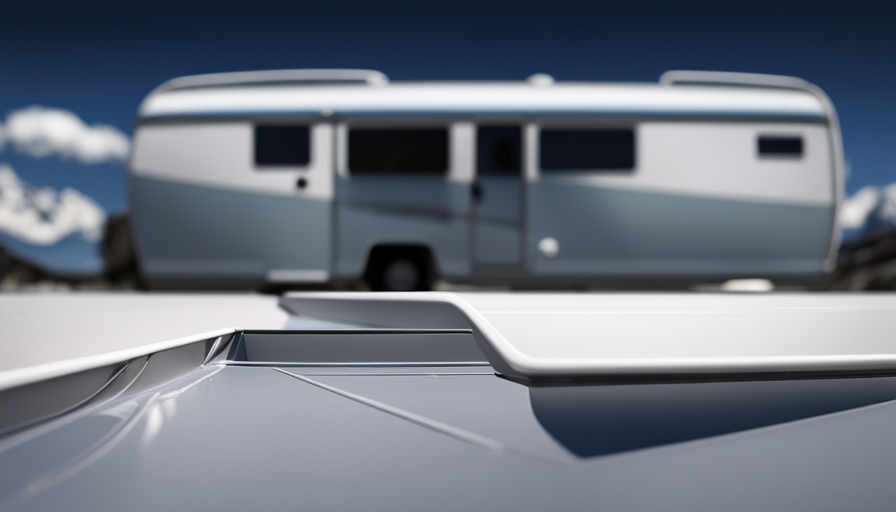You have decided to embark on a camping adventure in your trusty camper. Your gear is prepared, your destination is selected, and you are ready to hit the road. But before you depart, have you thought about protecting your camper’s water lines? Don’t worry, I’m here to assist.
In this article, I’m going to show you the step-by-step process of blowing out your camper’s water lines to prevent freezing and potential damage during those chilly winter months. It may seem ironic that while we seek the great outdoors to escape the confines of technology, we still rely on it to ensure our comfort and safety. But fear not, with a few simple tools and a bit of know-how, you’ll be able to properly winterize your camper and ensure that your water lines are in tip-top shape for your next adventure.
So, let’s dive in and get those water lines blown out!
Key Takeaways
- Properly draining and blowing out the camper’s water lines is essential to protect them during the winter and prevent frozen and burst pipes.
- It is important to follow a step-by-step process, starting from the farthest faucet to the main water inlet, to ensure all water is removed from the system.
- Using the right materials, such as an air compressor with a pressure regulator and a blowout plug, is crucial for effectively blowing out the water lines without causing damage.
- Regular maintenance of the camper’s water lines, such as insulating exposed pipes and keeping the interior warm, can help prevent freezing and maintain plumbing integrity.
Gather the necessary materials
Now, you’ll need to gather all the materials you’ll need for blowing out your camper water lines. Proper winterization techniques are essential to ensure that your camping water system stays in good working condition.
To start, you’ll need an air compressor with a pressure regulator. This will allow you to control the air pressure and prevent any damage to your water lines. Additionally, you’ll need a blowout plug that fits into your camper’s city water inlet. This plug will connect the air compressor to your water system.
Next, you’ll need a set of adjustable pliers to remove any water filters that are installed in your camper. It’s important to remove these filters before blowing out the lines, as they can become damaged if left in place. Additionally, you’ll need a water pressure gauge to monitor the pressure in your water system as you blow it out.
Once you have gathered all of these materials, you can move on to preparing your camper for the process. This involves draining all the water from your tanks, including the freshwater tank, gray water tank, and black water tank. It’s crucial to ensure that all valves and faucets are open to allow for complete drainage.
With these preparations complete, you’ll be ready to start blowing out your camper water lines.
Prepare your camper for the process
First, you’ll want to make sure your camper is ready by draining all the water from its system. Did you know that the average camper can hold up to 40 gallons of water? To prepare your camper for the water line blowout process, here are some important steps to follow:
- Turn off the water supply to your camper and disconnect any hoses or attachments.
- Open all the faucets and drains in your camper to allow the water to completely drain out. This will help prevent any residual water from freezing and causing damage during the winter months.
- Use compressed air to blow out the water lines. Attach the air compressor to the city water connection on your camper and set the pressure to around 30-40 psi.
- Begin blowing out the water lines starting from the farthest faucet or fixture and work your way towards the main water inlet.
- Once you have blown out all the water lines, make sure to close all the faucets and drains to prevent any debris or insects from entering the system.
Common mistakes to avoid during camper water line blowout include not properly draining the water lines and using too much pressure, which can cause damage to the lines. To maintain your camper water lines during winter, follow these tips: insulate exposed pipes, use heat tape, and keep the interior of the camper warm.
Now that your camper is prepared, let’s move on to the next section and locate the water lines in your camper.
Locate the water lines in your camper
To find the water lines in your camper, all you need to do is take a peek underneath and follow the trail of pipes and connections. It may seem daunting at first, but with a little patience and observation, you’ll locate them in no time. To make it easier, let’s break down the process into two simple steps: locating the main supply line and identifying the branch lines.
First, locate the main supply line. This is the main artery that delivers water throughout your camper. It is usually a larger pipe that connects directly to the water source. Trace this line from the water inlet to where it enters your camper. Along the way, you may encounter valves, filters, or pressure regulators that help control the water flow.
Next, identify the branch lines. These are the smaller pipes that connect to various fixtures and appliances in your camper. They branch off from the main supply line and deliver water to different areas, such as the kitchen sink, bathroom, and shower. By following these lines, you can get an idea of how the water is distributed throughout your camper.
Understanding the layout of your water lines is essential for several reasons. It allows you to properly insulate your camper’s water lines, ensuring they are protected from freezing temperatures. Additionally, it helps with troubleshooting common water line issues, such as leaks or low water pressure. Now that we’ve located the water lines, let’s move on to the next step: draining the water tanks and hot water heater.
Drain the water tanks and hot water heater
Once you’ve located the water lines in your camper, it’s time to drain the water tanks and hot water heater to ensure a fresh start for your next adventure. Flushing the water system is essential to prevent frozen pipes and maintain the integrity of your camper’s plumbing.
To begin, turn off the water supply to your camper and open all faucets, including both hot and cold water taps. This will release any pressure and allow the water to flow out smoothly.
Next, locate the drain valve on your water tanks and open it to drain the water. Be sure to have a bucket or hose ready to collect the water.
After draining the tanks, it’s important to flush the system with clean water. Close the drain valve and fill the tanks with fresh water. Open all faucets again, allowing the water to flow through and flush out any remaining debris or sediment. Repeat this process until the water runs clear.
Don’t forget to drain the hot water heater. Locate the drain valve on the heater and open it to release any water inside. This step will ensure that your hot water system is also thoroughly flushed.
With the water tanks and hot water heater drained, you’re now ready to connect the compressed air source and continue preparing your camper for winter storage or your next trip.
Connect the compressed air source
To ensure a smooth transition, you’ll want to connect the compressed air source to keep your camper’s plumbing system in top shape for winter storage or your next adventure. Proper maintenance of your compressed air source is crucial for effective water line blowouts. Here are some key steps to follow:
-
Check the air compressor: Before connecting the air source, ensure that your compressor is in good working condition. Check the pressure gauge, oil levels, and any filters to make sure they are clean and functioning properly.
-
Use a regulator: Attach a regulator to the air compressor to control the air pressure. It is important to set the pressure at a safe level to avoid damaging the plumbing system. Refer to your camper’s manual for the recommended pressure range.
-
Connect the air hose: Use a suitable air hose to connect the compressor to the camper’s plumbing system. Make sure the connections are secure and leak-free. A quick-connect fitting is a convenient option for easy attachment and detachment.
-
Open all faucets and drain valves: This step will be discussed in the next section, but it is important to mention it here as it is the next step after connecting the compressed air source.
By following these steps, you can properly maintain your compressed air source and avoid common mistakes when blowing out water lines. Now, let’s move on to the next step of opening all faucets and drain valves.
Open all faucets and drain valves
Now that your compressed air source is connected, it’s time to let the faucets and drain valves flow freely, releasing the stagnant energy and clearing the path for new possibilities.
To properly flush out camper water lines, follow these steps:
-
Begin by opening all the faucets in your camper, including both hot and cold water taps. This will allow any trapped water to escape and prevent damage from freezing during winter storage.
-
Next, locate the drain valves for your freshwater and hot water tanks. Open these valves to drain any remaining water from the system. Be sure to follow any specific instructions provided by the manufacturer for your particular camper model.
-
Finally, don’t forget to open any additional drain valves or low points in the water lines. These are usually found near the water pump or underneath the camper. By opening these valves, you can ensure that all water has been removed from the system, preventing any potential freezing or damage.
If your camper water lines are frozen, it’s crucial to thaw them out before attempting to blow them out. Follow the manufacturer’s instructions for thawing frozen water lines. Once they’re thawed, proceed with the flushing process described above.
With the faucets and drain valves open, the path is now clear for the next step: blowing out the water lines.
Begin blowing out the water lines
As you release the compressed air, watch as the trapped water dances its way out of the faucets and drain valves, clearing the path for a fresh start. This step is crucial in preventing frozen pipes and ensuring the longevity of your camper. Winterizing your camper is of utmost importance to avoid costly repairs and potential damage caused by freezing temperatures.
To begin blowing out the water lines, make sure all faucets and drain valves are open. This will allow for the water to escape and prevent any residual water from freezing and expanding, leading to cracked pipes. Connect an air compressor to the city water inlet using a blowout plug or adapter. Set the compressor to a low pressure setting, around 30-40 psi, to avoid damaging the water lines.
Start by blowing out the furthest faucet from the water inlet. Slowly open the valve and let the air flow through the lines. Move systematically from one faucet to another, working your way towards the water inlet. Repeat this process for each water line, including the shower, toilet, and outdoor kitchen if applicable.
By properly blowing out the water lines, you’re taking the necessary steps to prevent frozen pipes and ensure the longevity of your camper’s plumbing system. Now, let’s move on to the next section about how to repeat this process for each water line.
Repeat the process for each water line
Once you’ve completed the first step of blowing out the water lines, it’s time to go through the process again for each individual water line in your camper. This ensures a thorough blow out and proper winterization. Start by closing the faucets and drains you opened in the previous step. Next, attach the air compressor to the city water inlet using a blowout plug. Set the air compressor to around 30 PSI. Begin by opening the faucet furthest from the city water inlet and let the air blow through until only air comes out. Then, move to the next closest faucet and repeat the process. Continue this until you’ve blown out all the water lines in your camper.
To help you visualize the process, here’s a table that breaks down the steps for each water line:
| Water Line | Step 1: Open Faucet | Step 2: Attach Air Compressor | Step 3: Blow Out |
|---|---|---|---|
| Kitchen | |||
| Bathroom | |||
| Shower | |||
| Outdoor |
By following this blow out winterization method for each water line, you ensure proper water line maintenance and prevent any potential damage that may occur due to freezing temperatures. Once you’ve completed blowing out each water line, it’s time to move on to the next step and check for any remaining water.
Check for any remaining water
To make sure your water lines are completely free of any remaining moisture, go through each faucet and drain in your camper and see if any water drips out. This step is crucial in preventing water damage and ensuring that your camper is properly winterized.
Start by turning on each faucet, both hot and cold, one at a time. Allow the water to run for a few minutes and then turn it off.
Next, go to each drain, including the sink and shower drains, and check for any water drips. If you notice any leaks, it’s important to address them immediately to prevent any potential water damage.
Don’t forget to also check the toilet and any outdoor shower or hose connections. Even a small amount of water left in these areas can cause problems when temperatures drop below freezing.
By thoroughly checking each faucet and drain, you can be confident that your camper’s water lines are completely drained and ready for winter. This will give you peace of mind knowing that you have taken the necessary steps to protect your camper from potential damage caused by freezing temperatures.
Now, let’s move on to completing the winterization process.
Complete the winterization process
Make sure you’ve covered all the necessary steps to winterize your RV before the temperature drops. Properly winterizing your camper is crucial to prevent any damage caused by freezing temperatures. Failing to do so can result in costly repairs and a shorter lifespan for your RV.
To complete the winterization process, follow these steps:
-
Drain all water from the camper’s tanks and lines. Start by removing the drain plug and opening all faucets, including the shower and toilet. Allow all the water to completely drain out.
-
Use compressed air to blow out any remaining water. Connect an air compressor to the water inlet and set the pressure to around 30 psi. Open each faucet, one at a time, starting from the closest to the water inlet. Allow the compressed air to blow out any remaining water from the lines.
Here’s a helpful table to guide you through the process:
| Step | Action |
|---|---|
| 1 | Drain all water from tanks and lines |
| 2 | Connect air compressor to water inlet |
| 3 | Open faucets one at a time to blow out water |
By following these steps and properly winterizing your camper, you can avoid common mistakes such as leaving water in the lines, which can lead to frozen and burst pipes. Taking the time to winterize your RV will ensure that it remains in good condition and ready to use when warmer weather returns.
Frequently Asked Questions
How do I choose the right compressed air source for blowing out water lines in my camper?
To choose the right compressed air source for blowing out water lines in your camper, consider the benefits it offers. Compressed air provides a powerful and efficient method to remove water from the lines, preventing freezing and potential damage.
It is important to select an air source that can deliver sufficient pressure and volume to effectively clear the lines. Alternatively, other methods like using antifreeze or a hand pump can be used, but compressed air is often the preferred choice due to its effectiveness.
Can I use a hairdryer or other household appliance to blow out the water lines instead of a compressed air source?
Using a hairdryer or household appliance as an alternative method to blow out water lines in your camper may seem convenient, but it comes with potential risks. These appliances lack the necessary power and pressure to effectively remove all the water from the lines. This can lead to residual water freezing and causing damage. It’s crucial to use a compressed air source specifically designed for this task, ensuring a thorough and safe water line blowout.
Are there any specific safety precautions I should take when blowing out the water lines in my camper?
When it comes to blowing out the water lines in my camper, I always prioritize safety precautions to prevent water damage.
First and foremost, I make sure to wear protective eyewear and gloves to shield myself from any potential harm.
Additionally, I carefully inspect the water lines for any cracks or leaks before proceeding.
It’s crucial to use a regulated air pressure, around 40-50 psi, to avoid any damage to the lines.
By taking these safety measures, I can effectively maintain the integrity of my camper’s water system.
How often should I blow out the water lines in my camper to prevent damage or freezing?
To prevent damage or freezing, it’s recommended to blow out the water lines in your camper at least once a year before winter storage. The process typically takes around 30 minutes to an hour, depending on the size of your camper.
Here’s how to do it:
- Start by draining all the water from the system.nn2. Use an air compressor to blow out any remaining water.nn3. Properly store your camper during the winter by ensuring it’s clean, dry, and protected from the elements.
Is it necessary to complete the winterization process after blowing out the water lines in my camper?
It’s possible to overwinter a camper without blowing out the water lines, but it’s not recommended. Properly draining the water lines before blowing them out is crucial to prevent any residual water from freezing and causing damage.
To do this, start by turning off the water supply and opening all faucets and drains to allow the water to flow out completely. Then, use an air compressor to blow out any remaining water from the lines, ensuring they’re completely dry.
What is the Importance of Blowing Out Camper Water Lines before Renting?
Before renting a camper, it’s essential to understand the importance of blowing out camper water lines. Neglecting this crucial step can lead to frozen or burst pipes, resulting in costly repairs and delays. By properly blowing out the water lines, you can safeguard against potential damage, ensuring a hassle-free camping experience. So, before finalizing any camper rental prices, ensure that the water lines are well-prepared for your trip.
Conclusion
In conclusion, blowing out camper water lines is a crucial step in winterizing your camper and preventing expensive damage. By following the steps outlined in this article, you can ensure that all water is properly removed from your lines, tanks, and hot water heater.
Remember, this process may seem daunting at first, but with the right materials and a bit of patience, you can easily complete it. So don’t delay, take action now and safeguard your camper from freezing water that could potentially burst your pipes like a firework on the Fourth of July!










